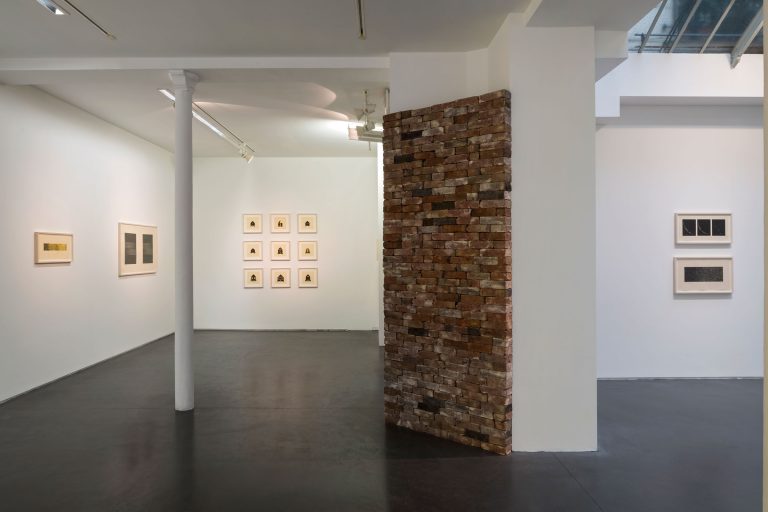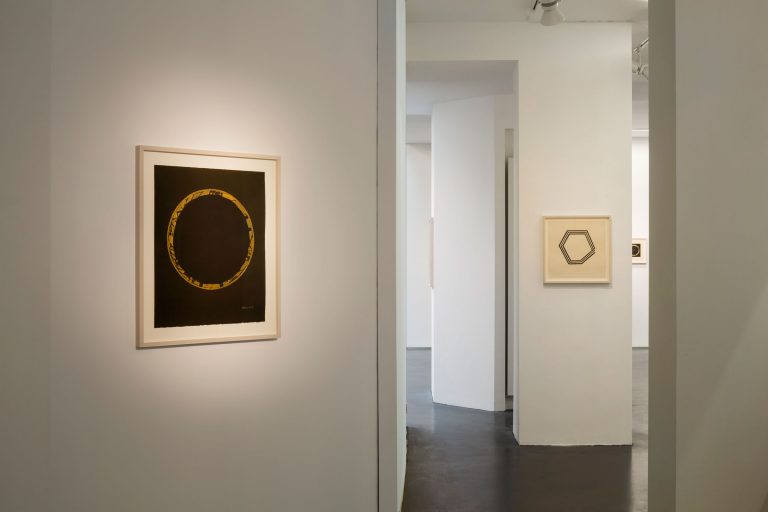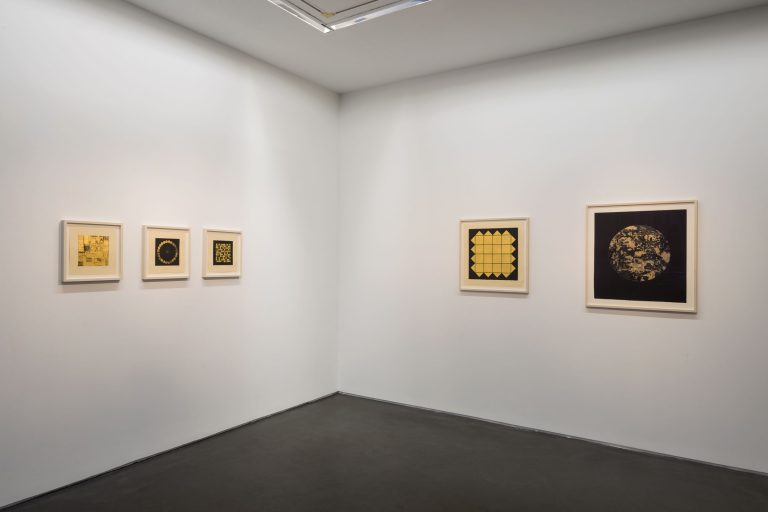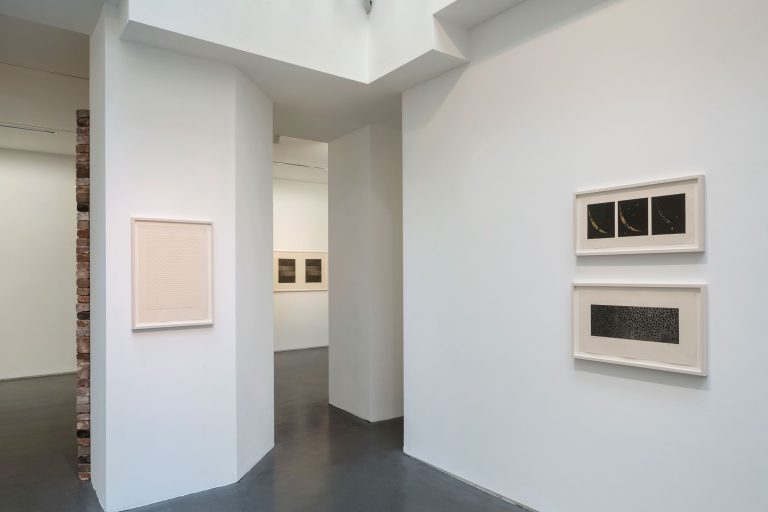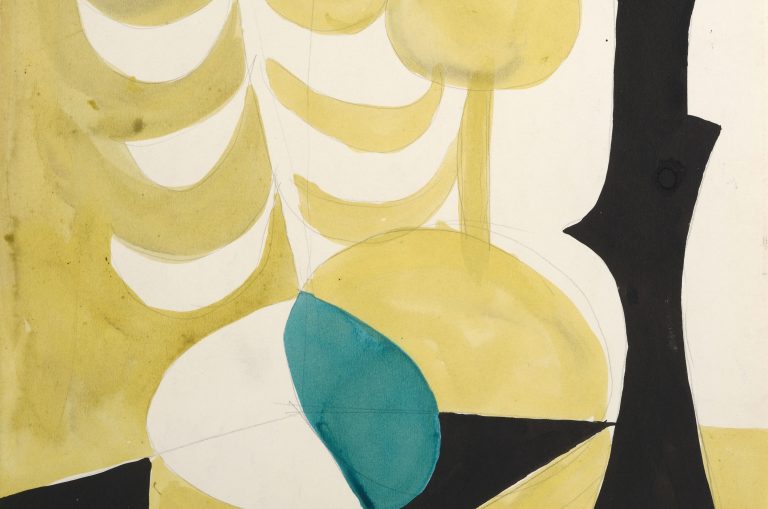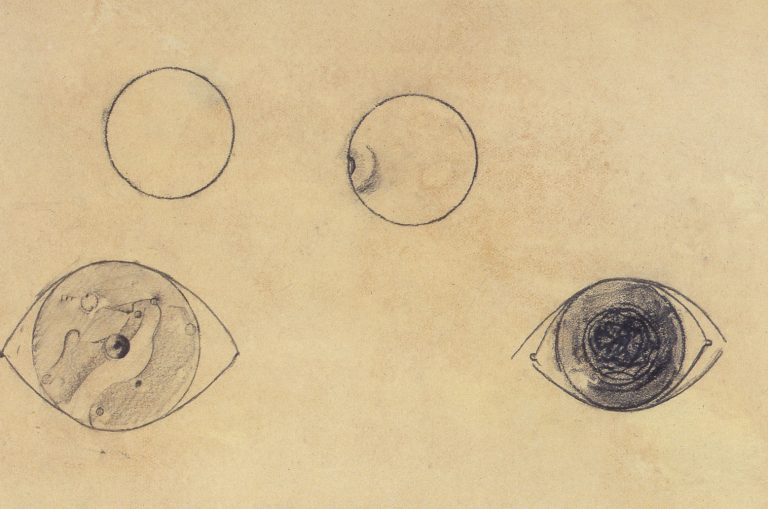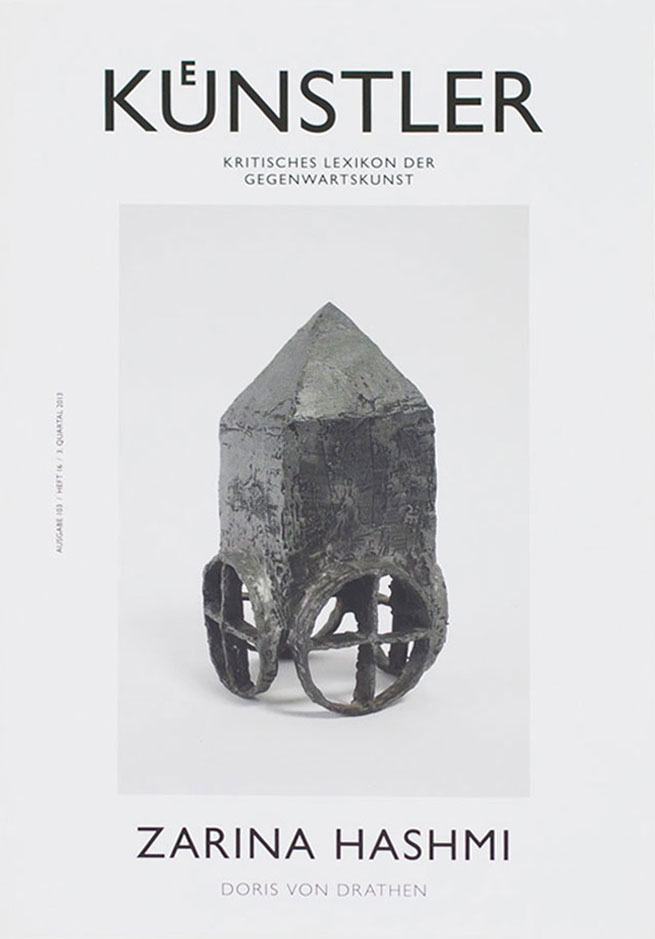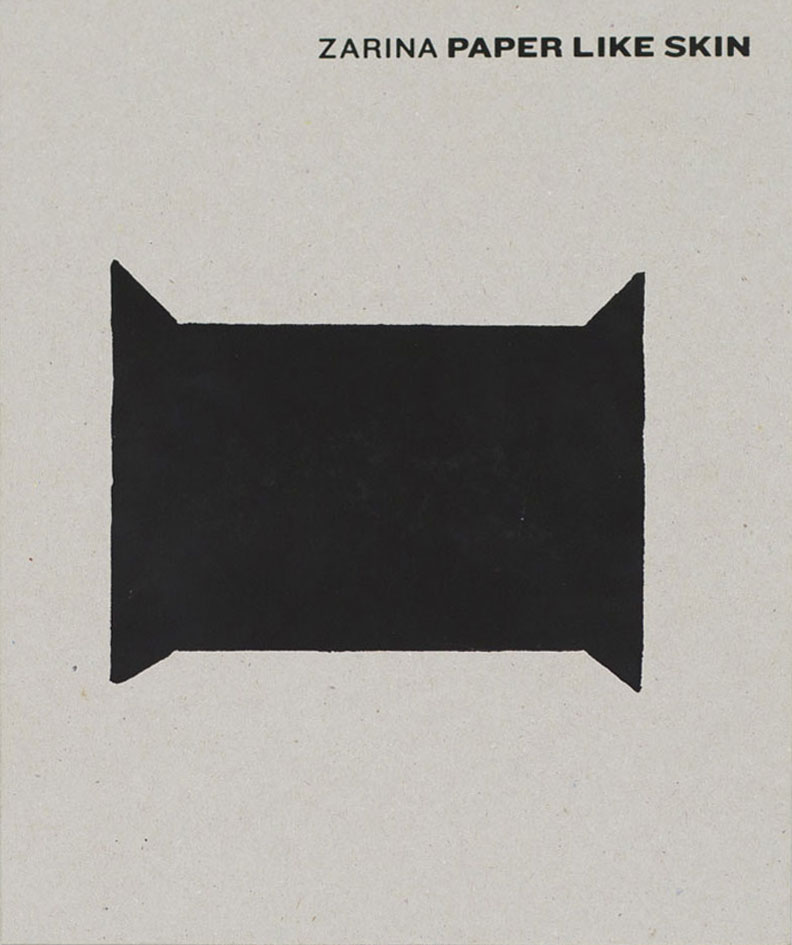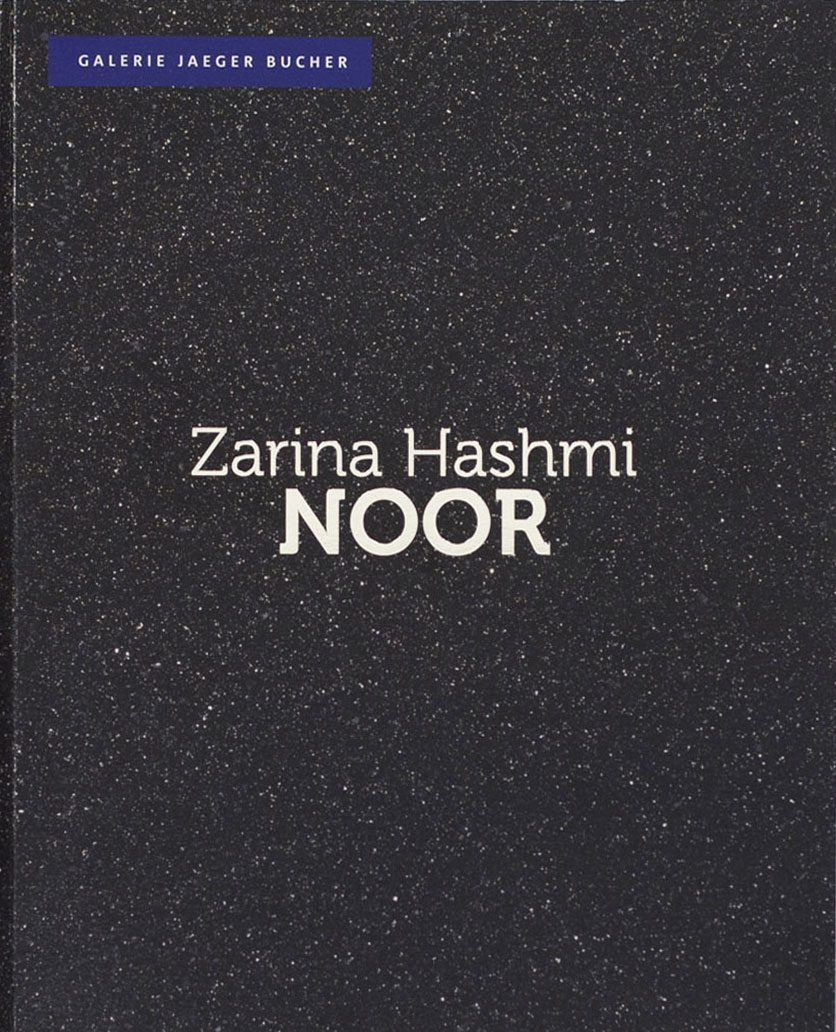Jeanne Bucher Jaeger - Marais Space
Photograph by Hervé Abbadie
Jeanne Bucher Jaeger - Marais Space
Photograph by Hervé Abbadie
Jeanne Bucher Jaeger - Marais Space
Photograph by Hervé Abbadie
Jeanne Bucher Jaeger - Marais Space
Photograph by Hervé Abbadie
As Zarina was moving forward in age and further along her spiritual path, her work shifted towards the location of her last trip, which she translated through her research on the divine light Noor, that has found shape through the use of obsidian ink and Sumi ink, prayer necklaces, tasbih in pearl or onyx-marble, and gold leaf.
Born in Aligarh, in the Northen Indian region of Uttar Pradesh, Zarina has always made her personal life the subject of her Art. She was one of the rare women artists of her generation that has managed to forge a true identity with her etchings and sculpture works on the subject of the Partition of India, exile and the longing for home. Her works, made mostly out of paper, woodcarved, woven, pierced, sculpted, are the music scores of a continuous memory, initiated in a cultivated intellectual family background, where history was taught by her father and literature and poetry contributed to the refinement of her spirit. Her love of books as well as reading remained all her life, to such an extent that she was defining paper as a second skin, as well as her attachment to words, which preceeded image, and to her mother-tongue Urdu which she integrates continuously in her work. Her studies of Mathematics and her fascination for the purity of Mughal architecture, with its perfect symmetry, purity and balance, are determining for the development of her work thus shaping a rite of passage towards mysticism.
The Indian Partition, an artificial border imposed in 1947 as she is 10 years old, marks deeply Zarina and initiates a cycle of exile. This exile is pursued by her wedding to an Indian diplomat, in 1958, whom she will follow across cities, countries, continents where she travels for more than 20 years until New York, where she decides to reside in 1976.
Her trips allow her to follow the teachings of great masters of engraving like Toshi Yoshida in Japan and Stanley Hay-ter in the Atelier 17 in Paris. Zarina works mostly on wood engraving, with papers coming from all around the world; she maps out, during her stays in these countries, multiple political conflicts and their collateral effects: the partition of India when she was 10 years old; the progressive loss of Urdu, her mother tongue; and wars of religion or the alteration of borders, especially that of separated India, which led to the migration of her entire family to Karachi, causing irrevocable nostalgia for the lost land
Zarina is best known for her series of etchings and woodblock prints that express the estrangement of migration, geographical dislocation and exile, captured in works such as Travels with Rani, 2008, a dotted diagram of all the towns and train stations she had passed through with her sister, or more recently in the serie entitled Refugee Camps with collage works such as Without Destination, 2016, and A Child’s Boat for Aylan and Ghalib, 2015, which allude to the painful contemporary refugee conflict at the borders of Europe.
The house is a recurrent subject in the work by Zarina. The portfolio of 5 woodblock engravings entitled Cities I Called Home, 2010 is inspired from her nomadic life between Aligarh, Bangkok, New Delhi, Paris, New York. Home is a Foreign Place from 1997, an iconic work composed of 36 engravings express more than ever, in her characteristic minimalistic language, the feeling of uprooting and exile : “I do not feel at home anywhere, but the idea of home follows me wherever I go” – Zarina.
In her late works, Zarina returned to the theme of the house in the serie entitled Folded House, 2016, presenting multilple articulations of miniature houses, composed of collages of black paper covered with gold leaf and thread.
At the crossroads between architecture, sculpture, and xylography, her engravings on wood, her one-of-a-kind works on paper placed as mural installations, and her casts sculpted in paper pulp accompany her life journey; her work, whose main material is paper which she considers as a second skin which breathes, grows old, can be stained, or else pierced and molded, is rich in the tactile quality of the materials whose numerous possibilities the artist explores. Her attachment to the practice of other religions and truths is primordial, from Sufism, the pre-dominant philosophy of Islamic India, to Buddhism.
The poetic significance of her work far surpasses its socio-political-cultural context, as it offers reminiscences of sounds, colors and odors, and emphasizes the symmetry and balance of the pure structural forms of Moghul architecture, and, above all, the Nastaleeq calligraphy of her maternal language, Urdu, omnipresent in her work, always preceding image. Far from limiting itself to an archeology of the past, Zarina’s work brings into being places and atmospheres shaped by imagination or desire, sculpted and sized to the light of hopes rooted in the material of paper, which has the capacity to at once breathe and to grow old, a fragility and a resistance that have traversed time. Her favorite materials are wood, which she carves, and paper, which she manipulates with extreme precision and knowledge, to the point where she knows the material’s entire history. Evoking ancient writing tablets, her sculptures in paper pulp let one glimpse all the marks of their time, in their pure form as geometry or sacred architecture, plunging us at once into the fractal universe of nature and the majestic universe of Islamic palaces and monuments. They also display rich textures and colors of stone that Zarina expresses through innumerable varieties and mixes of terra cotta, ivory, Siena pink, charcoal, graphite, and ochre pigments. A memorial parchment, Zarina’s work is the expression of a personal atlas, of vast and multiple paths across continents and civilizations.
Highly representative artist of South Asia, Zarina has been exhibited by reknown museum institutions and is supported by the Gallery Jeanne Bucher Jaeger, Paris, since 2008 through several solo and group shows, as well as loans to major international museums. In 2016, the gallery showcased a new solo show entitled Life Lines, which opened up for a reflection on the guiding line in the life of the artist. Zarina was also one of the four artists selected to represent the Indian Pavillion at the 54th Venise Biennial in 2011.
Zarina’s work is represented in major public collections, at the MoMA, Whitney, Guggenheim, and Metropolitan Museums in New York; at the Art Institute of Chicago, the Menil Foundation in Houston, the Hammer Museum in Los Angeles; in Europe at the Centre Pompidou, the BNF (National Library) in Paris, the LaM (Lille metropolitan museum of modern, contemporary and outsider art) in Villeneuve d’Asq, North of France, the Tate Gallery in London, the Contemporary Art Museum in Delhi… Her first exhibition in Paris dates back to 2008 for the inaugural exhibition in our new space, followed in 2011 by her solo exhibition Noor. A retrospective traveling exhibition of her work, entitled “Zarina: Paper like Skin”, was presented in the United States in 2012, first at the Hammer Museum in Los Angeles, then at the Guggenheim in New York and at the Chicago Art Institute.
These past few years, Zarina became more and more convinced that a superior force guided her life. In the acceptation of this light, which she lately translated by using gold leaf in her work, her artistic voyage across continents and civilisations turned towards the universal, planets, stars and cosmos, an ultimate destination she has reached on April 25th 2020. Zarina was in Wimbledon, amongst her loved niece, nephew and their families.
She is leaving her work as a legacy, a sensitive, immanent and transcendent testimony, in perfect symbiosis with her thought as she felt memory was “the only possession which lasts throughout time. ”
downloads
downloads
Collage with pewter leaf and Arches black paper, mounted on BFK light paper printed with black ink
23,62 × 22,05 in
Collage with pewter leaf and BFK light paper stained, mounted on Somerset Antique paper
26,97 × 24,41 in
Cut Okawara paper gilded with 22-carat gold leaf
73 × 39,5 in
Photograph by Georges Poncet
Arches cover black paper covered with pewter leaf
44 × 28,3 in
Photograph by Georges Poncet
Mosaic of silk-screened paper collaged on Arches cover white paper
26,7 × 27,5 in
Photograph by Jean-Louis Losi
Edition of 25
36 woodcuts with Urdu text printed in black on handmade Indian paper, mounted on Somerset paper
105 × 87 in
Photograph by Jean-Louis Losi
Edition of 3
Cast paper
23 × 29 × 5 in
Photograph by Jean-Louis Losi
Edition of 2
Collage with pewter leaf and gold pencil mounted on Somerset Cream paper
32,5 × 23,5 in
Photograph by Georges Poncet
Set of 5 woodcuts, edition of 25
Aligarh-Bangkok-New Delhi-Paris-New York
Woodblocks printed in black on handmade nepalese paper mounted on Arches cover buff paper
26 × 20 in (each woodcut)
Photograph by Jean-Louis Losi
Collage with pewter leaf and Arches black paper, mounted on BFK light paper printed with black ink
23,62 × 22,05 in
Collage with pewter leaf and BFK light paper stained, mounted on Somerset Antique paper
26,97 × 24,41 in
Cut Okawara paper gilded with 22-carat gold leaf
73 × 39,5 in
Photograph by Georges Poncet
Arches cover black paper covered with pewter leaf
44 × 28,3 in
Photograph by Georges Poncet
Mosaic of silk-screened paper collaged on Arches cover white paper
26,7 × 27,5 in
Photograph by Jean-Louis Losi
Edition of 25
36 woodcuts with Urdu text printed in black on handmade Indian paper, mounted on Somerset paper
105 × 87 in
Photograph by Jean-Louis Losi
Edition of 3
Cast paper
23 × 29 × 5 in
Photograph by Jean-Louis Losi
Edition of 2
Collage with pewter leaf and gold pencil mounted on Somerset Cream paper
32,5 × 23,5 in
Photograph by Georges Poncet
Set of 5 woodcuts, edition of 25
Aligarh-Bangkok-New Delhi-Paris-New York
Woodblocks printed in black on handmade nepalese paper mounted on Arches cover buff paper
26 × 20 in (each woodcut)
Photograph by Jean-Louis Losi

